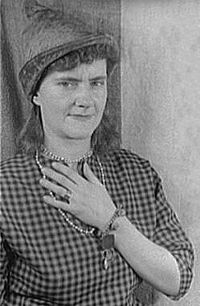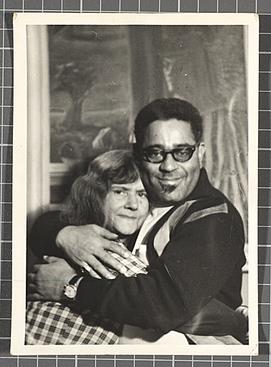Gertrude Abercrombie facts for kids
Quick facts for kids
Gertrude Abercrombie
|
|
|---|---|

Abercrombie in 1951
|
|
| Born | February 17, 1909 Austin, Texas, United States
|
| Died | July 3, 1977 (aged 68) |
| Nationality | American |
| Education | University of Illinois Art Institute of Chicago |
| Known for | Painting |
Gertrude Abercrombie (born February 17, 1909 – died July 3, 1977) was an American painter. She lived and worked in Chicago. People called her "the queen of the bohemian artists." This meant she was a central figure in the creative and free-spirited art scene.
Gertrude was very involved in Chicago's jazz music scene. She was friends with famous musicians like Dizzy Gillespie, Charlie Parker, and Sarah Vaughan. Their music often inspired her own unique paintings.
Contents
Growing Up and Education
Gertrude Abercrombie was born in Austin, Texas, on February 17, 1909. Her parents, Tom and Lula Janes Abercrombie, were opera singers. They were traveling when Gertrude was born.
In 1913, her family moved to Berlin, Germany. Her mother wanted to continue her singing career there. But when World War I started, they had to move back to the United States. The family lived in Aledo, Illinois, for a short time. Then, in 1916, they settled in Hyde Park, Chicago. Gertrude grew up in a very strict home environment.
She went to the University of Illinois at Urbana-Champaign. In 1929, she earned a degree in Romance languages. After that, she briefly studied figure drawing at the Art Institute of Chicago. She also took a one-year course in commercial art at the American Academy of Art in Chicago. This led to her first job drawing gloves for store advertisements. She also worked briefly as an artist for Sears.
Becoming a Fine Artist
In 1932, Gertrude decided to focus only on her own art. The next summer, she sold her first painting at an outdoor art fair in Chicago. She even received an honorable mention in the newspaper for her work.
In the mid-1930s, she moved out of her family's home. She became very active in the local art world. From 1934 to 1940, she worked as a painter for the Works Progress Administration. This was a government program that helped artists during the Great Depression. In 1934, the Chicago Society of Artists held a special show just for her art. During the 1930s and 1940s, she also started making woodcut prints.
Life and Inspirations
In 1940, Gertrude married a lawyer named Robert Livingston. In 1942, they had a daughter named Dinah. The couple later divorced in 1948.
That same year, she married Frank Sandiford, a music critic. The famous jazz musician Dizzy Gillespie even performed at their wedding! Gertrude and Frank were very involved in the bohemian and jazz scene in Chicago. This is how they knew so many musicians. Gertrude herself was a skilled improvisational pianist. She and Frank would often host parties and jam sessions at their Hyde Park home. Musicians like Sonny Rollins, Max Roach, Jackie Cain, and the Modern Jazz Quartet were her friends.
Gertrude was a unique person. She even inspired a song called "Gertrude's Bounce" by Richie Powell. He said she walked "just like the way the rhythm sounds." She also appeared in books by author James Purdy.
Later Life and Legacy
After 1959, Gertrude painted fewer pictures, and they were smaller. She became ill and needed a wheelchair. Eventually, she had to stay in bed. In the last year of her life, a big show of her art was held at the Hyde Park Art Center.
Gertrude Abercrombie died in Chicago on July 3, 1977. In her will, she created the Gertrude Abercrombie Trust. This trust shared her paintings and other artworks she owned with museums and art places across the Midwest. This way, many people could continue to enjoy her art.
Artistic Style and Themes
Gertrude Abercrombie painted many versions of her favorite subjects. These included simple rooms, empty landscapes, self-portraits, and still-lifes. Many of her paintings show a single woman in a long dress. This woman often has things linked to magic, like an owl, a black cat, a crystal ball, or a broomstick.
These women were often self-portraits of Gertrude herself. She once said, "it is always myself that I paint." Gertrude was tall and had sharp features. She thought she was ugly. Sometimes, she would wear a pointed velvet hat to look more like a witch. She enjoyed the feeling of power this gave her over others. Gertrude also got ideas for her paintings from her dreams. She used dreams to show reality mixed with fantasy. The 1940s and 1950s were her busiest and most creative years. During this time, she painted fewer portraits but kept her favorite themes.
Gertrude's later paintings were done in a very careful and controlled style. She didn't pay much attention to other artists' work. However, she did admire René Magritte. Gertrude mostly taught herself to paint. She didn't think that not having a lot of formal training was a problem.
Her art also showed her love for jazz music. This was inspired by the parties and jam sessions she hosted at her home. Dizzy Gillespie called her "the first bop artist." He meant that she took the feeling of jazz music and put it into her paintings.
Art Shows and Recognition
Group Exhibitions
- In Wonderland: The Surrealist Adventures of Women Artists in Mexico and the United States, Los Angeles County Museum of Art, 2012
Awards and Honors
- Prize, Annual Exhibition of Works by Artists of Chicago and Vicinity, 1936; 1938, Art Institute of Chicago
See also
 In Spanish: Gertrude Abercrombie para niños
In Spanish: Gertrude Abercrombie para niños
- Women Surrealists


